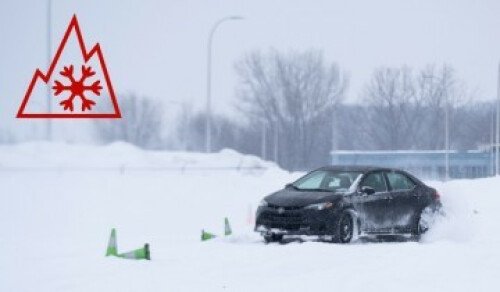
What is the difference between All-Weather and Winter tire?
Published on January 20th, 2021
What is the difference between an All-weather and a Winter tire?
As you may already know, winter tires are now mandatory on all motorized road vehicles registered in the province of Québec from December 1st to March 15th. However, as you may also recall, it has not always been the case. Indeed, our grand-parents lived through the creation of innovative new technologies such as the automobile radio, traffic signs and even winter tires which revolutionized the world of transportation. Invented in 1934 by Finnish engineers, winter tires have since been part of our wintry routine which inevitably saved countless lives.
Unlike other automobile related technologies, tires must be selected and purchased by the owner of the vehicle every few years. With new technologies being implemented every year, choosing the right tire for you can be quite confusing. Consequently, Quattro Tires intends to shed light on often obscure questions therefore allowing you to take an enlighten decision during your next tire purchase.
We certainly understand that tire shopping for the winter season can become quite confusing due to the terminology used throughout the industry. You surely came across “All-Season”, “All-Weather” as well as traditional winter tires during your research. However, did you know that these terms do not necessarily mean these tires will perform well during winter and may even be illegal depending on your province or area?
We will put to the test the three types of tires most commonly used during the Canadian* winter season in a series of exercises, stress-tests and evaluations performed in Québec, at the ICAR circuit of Mirabel.
*Take note that “All-season” tires are not legal for winter use in the province of Québec but are however used throughout the rest of Canada.
The tests were performed during sub-zero temperatures to truly challenge the efficiency of the selected winter tire models. Our professional pilots used an array of Toyota Corolla to tirelessly carry out multiple manoeuvres and stress-tests including accelerations, braking and handling, all executed in a controlled environment which included snowy and icy surfaces. The tests were executed using 205/55R16 tires, one of the most common dimensions among our clients. Additionally, we collected the data using professional tools such as the RaceLogic PerformanceBox which uses GPS positioning to calculate both speed and distances travelled with an astounding precision.
Braking
The most desired quality for a winter tire is undoubtedly its braking performances on snowy and icy surfaces. We therefore tested the three types of tires most commonly used during winter to demonstrate the differences in their behaviours and performances on the road in emergency situations.
According to the results from our evaluations, a true winter tire featuring the mountain and snowflake symbol will provide greater safety compared to the All-Season tires without the mountain and snowflake symbol, which will lose most of their efficiency when exposed to temperatures as high as 7oC. Indeed, the use of an All-Season tire, even with the “M+S” nomenclature, will increase your braking distances by more than 30% compared to a true winter tire. On average, this is equivalent to the length of 3 cars which as you know, can make all the difference between stopping in time and provoking a car accident.
In counterparts, while opting for an All-Weather tire, featuring the mountain and snowflake symbol, you can expect a reduction in the braking distance of up to 14% while comparing it to an All-Season tire.
Acceleration
Furthermore, the second most important aspect of a winter tire would be its capability to move your vehicle during the harsh winter conditions. Will you be able to clear that intersection once the light turns green or will you be left stranded in the middle of traffic because your tires couldn’t provide the necessary traction to get you moving?
It comes with no surprise that a truly dedicated winter tire will offer up to 40% more traction on snowy and icy surfaces than an All-Season tire.
In counterparts, All-Weather tires will offer great performances equalling only to a reduction of 10% in traction while compared to a true winter tire.
To demonstrate the difference in performance between the three types of tires used in Canada, we thoroughly tested each and every one of them. Without leaving you on the ice any longer, see the results for yourself below.
Conclusion
As you may have noted, a true winter tire will offer up to 40% more traction when used in sub-zero temperatures which greatly contrasts non winter approved tires that will lose the vast majority of their adherence while under temperatures as high as 7oC.
However, All-Weather tires will still offer respectable performances and may be enough for your needs depending on your province, area and driving conditions. While an All-Weather tire may prove enough for people doing only a minimal amount of travel during winter time or living in urban areas where the roads are consistently cleared. However keep in mind that those tires will have a reduced lifespan compared to All-Season tires due to their softer compound.
In light of our tests, we would definitely recommends drivers to have two different sets of tires, one set of All-season tires to use for 3 seasons, during warmer months, and a dedicated set of true Winter Tires for the colder months. As you have seen, the safety improvement makes this the safest solution for harsh Canadian winters.
Our team of experts would love to assist and help you select the perfect tire for your needs. Our experts remain available to answer any question you might have. If you require assistance, please reach us at 1-844-778-2887!

